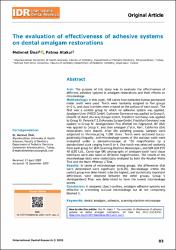| dc.contributor.author | Ünal, Mehmet | |
| dc.contributor.author | Atakul, Fatma | |
| dc.date.accessioned | 2022-07-05T09:35:56Z | |
| dc.date.available | 2022-07-05T09:35:56Z | |
| dc.date.issued | 2021 | en_US |
| dc.identifier.citation | Ünal, M., & Atakul, F. (2021). The evaluation of effectiveness of adhesive systems on dental amalgam restorations. International Dental Research, 11(2), 83-92. | en_US |
| dc.identifier.issn | 2146-1767 | |
| dc.identifier.uri | https://hdl.handle.net/20.500.12933/1325 | |
| dc.description.abstract | Aim: The purpose of this study was to evaluate the effectiveness of
different adhesive systems in amalgam restorations and their effects on
microleakage.
Methodology: In this study, 105 caries-free extracted human permanent
molar teeth were used. Teeth were randomly assigned to five groups
(n=21), and class I cavities were created on the surface of each tooth. The
first was a control group to which no adhesive system was applied.
Amalgam Liner (VOCO GmbH, Cuxhaven Germany) was applied to Group II,
Clearfil SE-Bond (Kuraray Europe GmbH, Frankfurt Germany) was applied
to Group III, Panavia F 2.0 (Kuraray Europe GmbH, Frankfurt Germany) was
applied to Group IV, Amalgambond Plus (Parkell Inc.Edgewood, NY USA)
was applied to Group V, and then amalgam (Tytin, Kerr, California USA)
restorations were placed. After the polishing process, samples were
subjected to thermocycling 1,000 times. Teeth were sectioned buccopalatinally/lingually, and microleakage scores of the occlusal walls were
evaluated under a stereomicroscope at 15X magnification by a
standardized scale ranging from 0 to 4. One tooth was selected randomly
from each group for SEM (Scanning Electron Microscope), and SEM LEO EVO
40 (LEO Ltd., Cambridge UK) photographs of amalgam-tooth hard tissue
interfaces were also taken at different magnifications. The results of the
microleakage tests were statistically analyzed by both the Kruskal-Wallis
Test and the Mann Whitney U Test.
Results: In terms of microleakage among groups, the differences that
were determined were significant (p<0.05). Microleakage within the
control group was determined to be the highest, and statistically important
differences were observed between the other groups. Group V
(Amalgambond Plus) was determined to have the lowest microleakage
scores.
Conclusion: In prepared class I cavities, amalgam adhesive systems are
effective in preventing occlusal microleakage but do not completely
blocked it. | en_US |
| dc.language.iso | eng | en_US |
| dc.publisher | Dicle University | en_US |
| dc.rights | info:eu-repo/semantics/openAccess | en_US |
| dc.subject | Dental amalgam | en_US |
| dc.subject | Adhesive | en_US |
| dc.subject | Scanning electron microscope | en_US |
| dc.title | The evaluation of effectiveness of adhesive systems on dental amalgam restorations | en_US |
| dc.type | article | en_US |
| dc.authorid | 0000-0001-9111-6962 | en_US |
| dc.department | AFSÜ, Diş Hekimliği Fakültesi, Klinik Bilimler Bölümü | en_US |
| dc.contributor.institutionauthor | Ünal, Mehmet | |
| dc.identifier.volume | 11 | en_US |
| dc.identifier.issue | 2 | en_US |
| dc.identifier.startpage | 83 | en_US |
| dc.identifier.endpage | 92 | en_US |
| dc.relation.journal | International Dental Research | en_US |
| dc.relation.publicationcategory | Makale - Uluslararası Hakemli Dergi - Kurum Öğretim Elemanı | en_US |
















